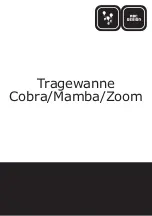
19
maximum current limit and not allow lREC to exceed its temperature limits. Even at a reduced
current limit, the vehicle will normally be able to reach sufficient speed for full lA operation, thereby
allowing the panel to cool. As the panel cools, the thermal protector will automatically return the
control to full power.
LOW VOLTAGE
- batteries under load, particularly if undersized or more than 80 percent dis-
charged, will produce low voltages at the SCR control terminals. The EV-l00 control is designed for
use down to 50 percent of a nominal battery volts of 36-84 V, and 75 percent of a nominal battery
volts of 24 V. Lower battery volts may cause the control to not operate correctly; however the PMT
should open the F or R contactor in the event of a commutation failure.
FIELD WEAKENING
- if the vehicle is supplied with a field weakening circuit, the FW PU and
FW DO (function 7 and 8) can be adjusted from the handset unit. Field weakening is a method of
attaining higher running speed for the vehicle in level operation. The normal settings for this feature
are: pickup of FW contactor from l25 to l50 percent of normal full-load running current (lA), and
dropout of FW contactor from 275 to 300 percent current. The dropout puts the motor back to the
lA range to climb ramps and inclines.
REGENERATIVE BRAKING
if the vehicle is moving and the directional lever is moved from one
direction to the other, this initiates a plugging signal by reversing the motor field. During the stan-
dard motoring mode and the plugging mode, the RB contactor remains picked up. In the plugging
mode, the motor armature acts as generator. Once the generated current reaches a particular current
level, the plugging mode transitions to regenerative braking mode.
Transitioning to regenerative braking mode, opens the RB contactor, disconnecting the motor arma-
ture from battery negative and inserting 7REC and REGEN SENSOR-2 in the regen circuit. During
the lREC on time, the field and armature current is increased. During the 1REC off time, the energy
stored in the field and armature generates the regenerative current, which passes through 7REC, #2
sensor, battery, 3REC/4REC and back to motor field and armature.
The control will remain in regenerative mode as long as the regen current can maintain regenerative
current limit. When the regenerative current cannot be maintained and drops below the level set by
the regenerative current limit trimpot (RB C/L), the regenerative braking mode transitions back to
plugging mode. During the transition back to plugging mode, the RB contactor will reclose enabling
the control to function in plugging mode, regulating plugging currents to bring the vehicle to a
smooth stop and reversal. The accelerator potentiometer input will modulate plugging as well as
regenerative braking current. The major advantage of regen is longer motor life due to reduced motor
heating. This feature has two adjustable functions, regen current limit (function 9) and regen start
(function 10).
DUAL MOTOR OPERATION
- This function is used to connect the motor armatures of a dual
motor vehicle system in parallel during a plug if both motors are in operation at the time of the
plug cycle. This prevents the fields from building flux in the opposite directions and prohibits the
motors from acting as a series generator thereby causing uncontrollable plugging torques. This circuit
require the addition of an armature shorting contactor ( D contactor ) and an additional 4REC diode (
4REC-B). The D contactor only closes when both motors are energized during a plugging cycle.
Summary of Contents for EV100 LX
Page 3: ...3 EV100LX COMPONENT LOCATIONS ...
Page 4: ...4 EV100LX OUTLINE DRAWING ...
Page 5: ...5 EV100LX WITH SPEED LIMIT AND FW 9 ...
Page 6: ...6 EV100LX WITH REGEN AND FW 9 ...
Page 7: ...7 EV100LX DUAL MOTOR CONTROL 9 ...
Page 8: ...8 EV100LX PUMP CONTROL 9 ...
Page 10: ...10 EV100LX PART NUMBER IDENTIFICATION ...
Page 60: ...6 0 ...
Page 80: ...g GE Industrial Systems EV200LX SUPPLEMENT Page 4 of 5 REV 11 2002 Wiring Diagram ...
















































